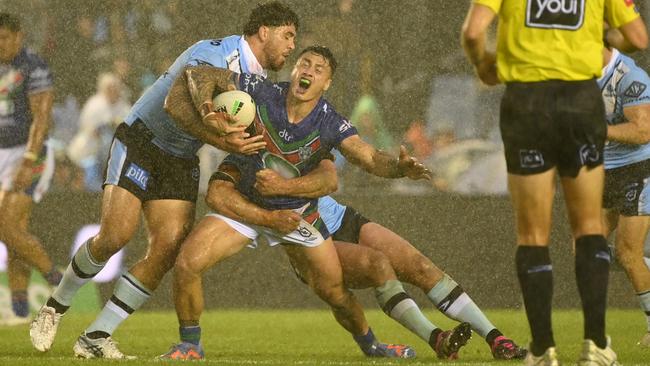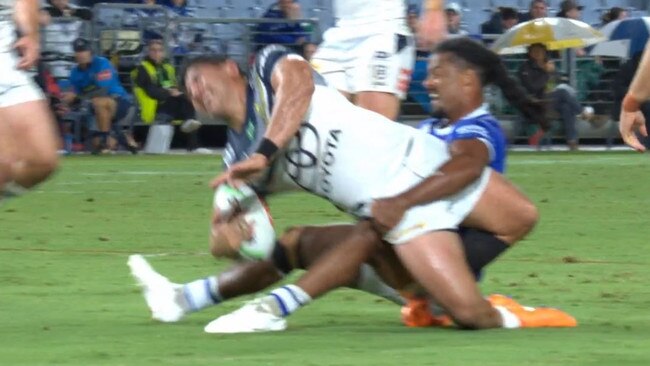Paul Kent: The moment that settled NRL hip drop debate once and for all
Any argument against the merits of the hip drop charges issued over the weekend now lay dead and slightly stiff – and here’s the emphatic proof, writes PAUL KENT.

NRL
Don't miss out on the headlines from NRL. Followed categories will be added to My News.
Any argument against the merits of the hip drop charges issued over the weekend now lay dead and slightly stiff after all three players took early guilty pleas.
The topic is done, even if the debate remains.
Various corners of the rugby league world covered their eyes in embarrassment over the weekend when Dale Finucane, Jayden Okunbor and Marata Niukore were all sin-binned for hip drop tackles that, as they said, in almost any other era would have gone unnoticed.
Some even questioned whether the Weekend Three would even get charged.
Proof has come from within, though, to show the NRL is on the right track. The proof was in all three men entered early guilty pleas midday on Tuesday.
No need for a hearing, don’t pass go.
They saw the evidence and put their hands up.

They did this even as some would argue they took the early plea only to claim the discount, arguing that to fight and lose was too costly, so better to be prudent.
Prudence has never been a strong point in the NRL.
In truth, they have the argument backwards. The early discount is an incentive for players who know they are guilty to take and avoid clogging up the judiciary Tuesday nights, given they would have nothing else to lose.
The game has a tackling problem and the NRL is slowly moving to turn it around.
Concussions are the dominant discussion as a combination of not just greater athleticism but also the poor technique that has infiltrated the game.
The culprit is not all late footwork at the line.
But wrestling techniques have been a blight on the game since not long after they stopped selling bubble gum in our packs of footy cards.
The game has had more than enough time to attack it and yet, now that they slowly are, some don’t like it.
It might have gone unnoticed in some of the caves us NRL-types live in but people are getting injured with these kinds of tackles.

Ankles are twisting in ways ankles are not designed to twist.
Bones are saying enough is enough and, usually by then, whatever tendons and cartilage there are have already cried uncle.
NRL head of football Graham Annesley was forced to come forward on Monday and say the three players charged were not part of a crackdown at all, just a conscientious move towards continuing to eliminate dangerous tackles from the game.
How anyone can argue with this is beyond the imagination of old grumpy here.
Tackling has changed significantly, so much so that coaches will admit that the legs tackle exists only once they have already been beaten defensively.
A solid straight defensive line never has a need for a legs tackle.
Over time teams have changed how they defend to be more effective at stopping the play-the-ball speed, which is the dominant indicator of how a team best sets itself up for victory.
The nasty little secret, of course, is that over time jujitsu coaches with their wrestling techniques have moved in to tell the leaguies how they can best slow a man down.
Lost in the translation from one sport to another, though, was that while jujitsu was a competition based on one-on-one, ball-runners are usually hit with defenders from various directions, all of whom like to take a good solid hold on them and wrestle their man down like it was an independent exercise.

So whereas the unwritten rule in jujitsu says where the head goes the body will follow, this was frighteningly untrue in the NRL when a tackler grabbed a rival’s neck to take him one way only to find a teammate had anchored his feet to the ground or was already intent on taking him another.
The game was far too slow to adapt and the jujitsu coaches were on their way, migrating from grapples to chicken wings to rolling pins to cannonballs and now, finally, the hip drop.
Hip drop tackles are ugly enough and dangerous enough that no player will actually admit to being taught it.
And not all have.
But there is enough evidence in the game at the very least to suggest it was taught somewhere or that players watch enough video in review to see its effectiveness and are able to replicate it.
Just a glimpse at the game’s violent history is enough to refute suggestions that players don’t go out to hurt their opponents.
Annesley gave the players the benefit of the doubt on Monday by saying the tackles were either “misjudgments, poor timing or accidental”.
Any debate on the legitimacy of the charges, though, was there at the judiciary.
Or more correctly not there, all three having stayed home after taking their guilty pleas.





